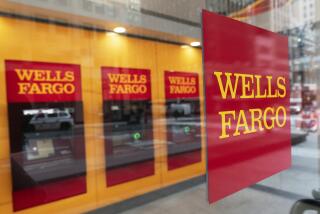Wells Fargo may have created 1.4 million more unauthorized accounts than we thought, attorneys say

Quick breakdown of the Wells Fargo scandal.
- Share via
Wells Fargo & Co. may have opened as many as 3.5 million unauthorized checking, savings and credit card accounts over the last 15 years — far more than originally reported by the bank and federal regulators, according to a new estimate from attorneys representing bank customers.
For months, the number of unauthorized accounts that bank employees may have created stood at 2.1 million. That figure, reported by regulators last year, was based on the San Francisco bank’s analysis of accounts opened and credit card applications submitted between May 2011 and July 2015.
But the attorneys, who are negotiating a class-action settlement with the bank, suggested in documents filed late Thursday that an additional 1.4 million unauthorized accounts were opened dating to 2002. That’s the year, according to a recent internal bank investigation, that Wells Fargo executives first noticed the problem of employees opening accounts without customer permission.
The new estimate is the latest in a series of revelations illustrating how the unethical sales practices at the bank may be deeper and broader than first imagined. Late last month, for instance, former employees alleged in court filings in a separate action that bank workers had targeted Native Americans, college students and immigrants in the country illegally to open unwanted accounts in their names.
The revelations have hampered the bank’s effort to move on from the scandal, which was spurred by unrealistic sales goals set by bank executives, ignored by the bank’s internal overseers and not adequately policed by bank examiners, according to investigations by the bank and regulators.
The new, higher figure is based on “public information, negotiations, and confirmatory discovery,” according to Thursday’s filing in U.S. District Court in San Francisco.
The filing cautions that the 3.5 million figure could be an overestimate, though a reasonable one.
Bank spokesman Ancel Martinez discounted the new number, but the bank has not released an updated figure of its own.
“The unauthorized account numbers reported in the filing are estimates made by plaintiffs’ attorneys based on a hypothetical scenario and have not been verified,” Martinez said. “The number of unauthorized accounts estimated in the filing do not reflect actual unauthorized accounts.”
Still, it stands to reason that the number of potentially unauthorized accounts would be significantly larger than the 2.1 million initially reported, given the longer time period now being scrutinized, said Scott Siefers, an analyst at investment bank Sandler O’Neill.
“Mathematically, it makes sense,” he said.
The latest estimate stems from several class-action lawsuits filed on behalf of customers that Wells Fargo agreed in March to settle for $110 million.
That deal would have provided payouts to customers who had unauthorized accounts opened for them as early as 2009. But last month, after Wells Fargo’s internal investigation reported problems dating back to 2002, the bank agreed to extend the deal back to that point and increase the settlement to $142 million.
In providing the new estimate of affected customers, the attorneys negotiating the deal are not seeking an additional increase in that payout. The estimate is cited in a document asking U.S. District Judge Vince Chhabria to approve the higher, $142-million settlement amount.
The judge will consider the request at a hearing to be held in San Francisco next week.
Despite the higher estimate, settlement documents filed so far have not made clear how many individual customers may be eligible for any payout. Many customers have alleged multiple unauthorized accounts were opened in their names.
If the settlement is approved, customers would be able to make claims for compensation, so the number of eligible settlement participants may grow beyond attorneys’ expectations.
Consumer advocates and attorneys for other Wells Fargo customers have said the revised settlement still isn’t enough.
Ed Mierzwinski, consumer program director at the U.S. Public Interest Research Group, said Friday that the new estimate of 3.5 million unauthorized accounts shows that regulators and attorneys should continue to dig into the bank’s practices.
“We need to keep Wells Fargo’s feet to the fire,” he said. “We don’t know everything yet. It’s like peeling open an onion — the depths of the Wells Fargo corruption and its abuse of its customers and front-line workers.”
The proposed settlement is the result of negotiations between Wells Fargo and attorneys at Seattle law firm Keller Rohrback, which represents a handful of bank customers from across the country.
The firm filed a lawsuit two years ago that alleged bank workers, driven by onerous sales goals, opened accounts for customers without authorization — precisely the kind of conduct that the Los Angeles Times first reported in 2013 and to which Wells Fargo has since admitted.
The settlement would allow customers who paid fees related to the accounts to get refunds, but only if they haven’t received refunds already. The bank has already paid $3.2 million in refunds independent of the class-action lawsuit.
Customers who say their credit was damaged by unauthorized accounts — either by unwanted credit inquiries or by debts caused by hidden fees — also would be paid back for added costs, a process that will involve checking customer credit scores.
Customers will have to show that their credit was harmed and that they took out a loan at a higher interest rate to be eligible for repayment of the extra costs.
Any settlement funds left over after refunds and credit-related payments will be split among eligible customers, based on the number of unauthorized accounts they had.
If approved, the settlement negotiated by attorneys in that case would apply to Wells Fargo customers nationwide, likely putting an end to nearly a dozen other class-action suits.
Attorneys in some of those cases have asked Chhabria to reject the settlement, arguing that the deal does not adequately compensate the bank’s victims and that customers could get more if they continue to press their court cases.
In a filing last week, attorneys who have brought cases against the bank in Georgia, Florida, North Carolina and Alabama argued that many bank customers may be able to win civil identity-theft claims against Wells Fargo. They said those claims could result in a much more lucrative payout than whatever customers are likely to get in the pending class-action settlement.
In Thursday’s filing, though, Derek Loeser and other Keller Rohrback attorneys said that they believe customers would not win identity-theft cases and that the deal they have negotiated with the bank is fair.
Part of the firm’s argument in favor of settling is that customers are unlikely to be able to pursue any class-action cases against the bank because of contract clauses that require customer disputes with the bank to be handled in private arbitration rather than in court.
Customers, including the ones represented by Keller Rohrback, have tried to sue the bank over unauthorized accounts, but judges — notably Chhabria himself — have rejected those cases because of Wells Fargo’s arbitration clause.
Despite that, Wells Fargo Chief Executive Timothy Sloan has said the $142-million settlement is “an important step to make things right for our customers.”
The new, higher estimate of the number of unauthorized accounts comes on the heels of a Wells Fargo investor event during which bank executives laid out a bevy of new initiatives aimed at holding on to customers and attracting new ones following the accounts scandal, which has tarnished the bank’s reputation and driven away potential new customers.
It’s also forced the bank, which long relied on its branch network to sell more products and services to customers, to rethink its strategy, said Siefers, the analyst.
“Wells was driven for decades by one overriding notion, and that was the idea of cross-selling,” he said. “They’ve had to really transform very rapidly. I think this has been a real jolt to the system.”
Follow me: @jrkoren
UPDATES:
4:05 p.m.: This article was updated with additional background on the accounts scandal and a comment from analyst Scott Siefers.
1:25 p.m.: This article was updated with a new quote from Ed Mierzwinski.
12:15 p.m.: This article was updated with a statement from Wells Fargo spokesman Ancel Martinez.
11:25 a.m.: This article was updated with additional details on the class-action lawsuits against Well Fargo and quotes from Wells Fargo CEO Timothy Sloan and Ed Mierzwinski of the U.S. Public Interest Research Group.
This article was originally published at 10:25 a.m.
More to Read
Inside the business of entertainment
The Wide Shot brings you news, analysis and insights on everything from streaming wars to production — and what it all means for the future.
You may occasionally receive promotional content from the Los Angeles Times.











